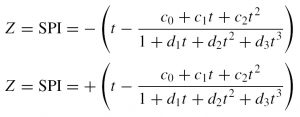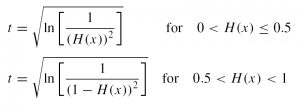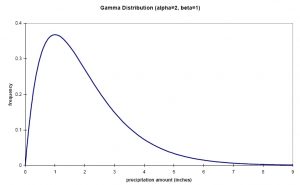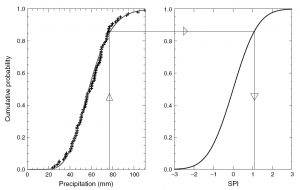Intensità massima rilevata per alcune regioni
Indice scelto a livello internazionale, attraverso la “Dichiarazione di Lincoln”, per l’identificazione di siccità meteorologiche (SPI 3 mesi).
Basato sulla sola precipitazione cumulata mensile (McKee et al., 1993), quantifica un deficit o surplus di pioggia rispetto ai valori medi, a diverse scale temporali (usualmente 1, 3, 6, 12, 24 e 48 mesi), consentendo la determinazione delle diverse tipologie di siccità, dalla meteorologica, all’agricola all’idrologica.
Le serie di pioggia (almeno 30 anni) vengono adattate in una distribuzione gamma, successivamente trasformata in un distribuzione normale, con media zero e deviazione standard pari a 1.
Tale standardizzazione permette il confronto fra diverse aree geografiche e climatiche.
Le equazioni da cui deriva lo SPI sono di seguito rappresentate:


dove H(x) è la probabilità cumulativa della pioggia x; c e d sono delle costanti.


La tabella seguente indica le classi di siccità o surplus in base ai valori dell’indice:

McKee T.B., Doesken N. J., Kliest J. (1993). The relationship of drought frequency and duration to time scales. In Proceedings of the 8th Conference of Applied Climatology, 17-22 January, Anaheim, CA. American Meterological Society, Boston, MA. 179-184.
Guttman, N. B. (1999). Accepting the Standandardized Precipitation Index: a calculation algorithm. J. Amer. Water Resour. Assoc., 35 (2), 311-322.
L’indice ESI (Evaporative Stress Index) quantifica anomalie temporali standardizzate del rapporto fra evapotraspirazione reale e potenziale e fornisce indicazioni “proxy” circa la rapida evoluzione dell’umidità superficiale del suolo e delle condizioni di stress delle colture.
I valori dell’indice, calcolato con aggregazioni di brevi periodi (es. 4 settimane), forniscono indicazioni circa cambiamenti rapidi, mentre aggregazioni più lunghe, che integrano dati su periodi di tempo maggiori (es. 12 settimane), sono rappresentative di cambiamenti più lenti.
Anderson, M. C., J. M. Norman, J. R. Mecikalski, J. P. Otkin, and W. P. Kustas, 2007a: A climatological study of evapotranspiration and moisture stress across the continental U.S. based on thermal remote sensing: I. Model formulation. J. Geophys. Res., 112, D10117, doi:10110.11029/12006JD007506.
Anderson, M. C., J. M. Norman, J. R. Mecikalski, J. P. Otkin, and W. P. Kustas, 2007b: A climatological study of evapotranspiration and moisture stress across the continental U.S. based on thermal remote sensing: II. Surface moisture climatology. J. Geophys. Res., 112, D11112, doi:11110.11029/12006JD007507.

dove NDVIi, NDVImin, e NDVImax sono rispettivamente l’ultima immagine NDVI disponibile ed i valori minimo e massimo assoluti lungo la serie temporale, riferiti allo stesso periodo.
Nonostante l’NDVI sia calcolato per tutto l’anno, durante il periodo autunno-invernale le immagini satellitari sono più influenzate dalla maggiore copertura nuvolosa che contraddistingue questi mesi più freddi.
Il dataset degli indici di vegetazione (DOI: 10.5067/MODIS/MOD13Q1.006) utilizzato per il calcolo del VCI e dell’E-VCI proviene dall’elaborazione delle immagini dello strumento MODIS (Moderate Resolution Imaging Spectroradiometer) del satellite Terra (EOS AM-1).
Kogan, F. N. (1995). Application of vegetation index and brightness temperature for drought detection. Advances in Space Research. 15, 91-100.
Articoli della stampa locale e nazionale per il periodo considerato.
| Cookie | Durata | Descrizione |
|---|---|---|
| cookielawinfo-checkbox-advertisement | 1 year | Set by the GDPR Cookie Consent plugin, this cookie is used to record the user consent for the cookies in the "Advertisement" category . |
| cookielawinfo-checkbox-analytics | 1 year | Set by the GDPR Cookie Consent plugin, this cookie is used to record the user consent for the cookies in the "Analytics" category . |
| cookielawinfo-checkbox-functional | 1 year | The cookie is set by the GDPR Cookie Consent plugin to record the user consent for the cookies in the category "Functional". |
| cookielawinfo-checkbox-necessary | 1 year | Set by the GDPR Cookie Consent plugin, this cookie is used to record the user consent for the cookies in the "Necessary" category . |
| cookielawinfo-checkbox-others | 1 year | Set by the GDPR Cookie Consent plugin, this cookie is used to store the user consent for cookies in the category "Others". |
| cookielawinfo-checkbox-performance | 1 year | Set by the GDPR Cookie Consent plugin, this cookie is used to store the user consent for cookies in the category "Performance". |
| CookieLawInfoConsent | 1 year | Records the default button state of the corresponding category & the status of CCPA. It works only in coordination with the primary cookie. |
| elementor | never | This cookie is used by the website's WordPress theme. It allows the website owner to implement or change the website's content in real-time. |
| Cookie | Durata | Descrizione |
|---|---|---|
| __cf_bm | 30 minutes | This cookie, set by Cloudflare, is used to support Cloudflare Bot Management. |
| pll_language | 1 year | The pll _language cookie is used by Polylang to remember the language selected by the user when returning to the website, and also to get the language information when not available in another way. |
| Cookie | Durata | Descrizione |
|---|---|---|
| _pk_id.1.a87b | 1 year 27 days | No description |
| _pk_ses.1.a87b | 30 minutes | No description |
| AWSALBTG | 7 days | No description available. |
| AWSALBTGCORS | 7 days | No description available. |
| experiments-fingerprint | 6 months | No description |
| experiments-raw | 6 months | No description |
| sessionid | 14 days | No description |